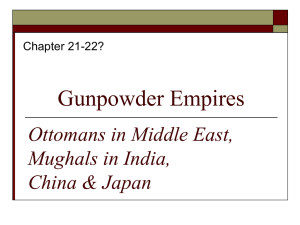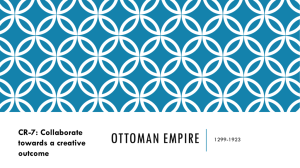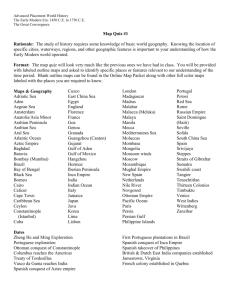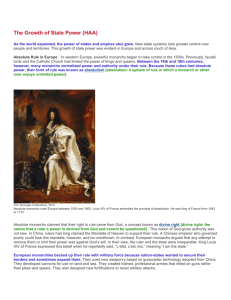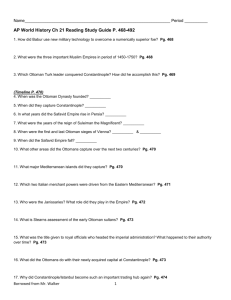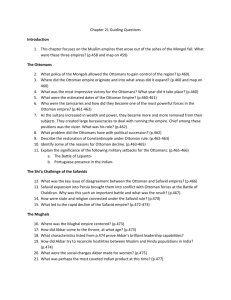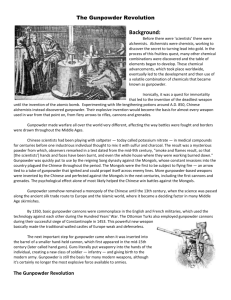The Gunpowder Empires (1400
advertisement
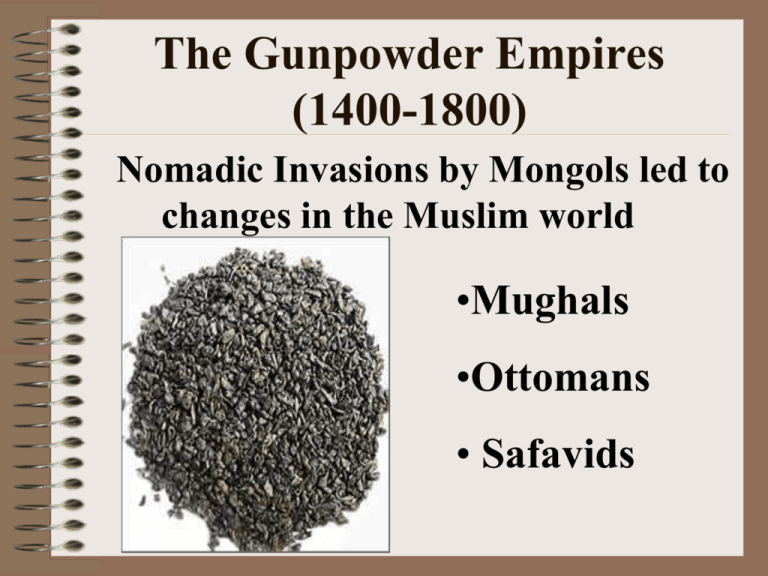
The Gunpowder Empires (1400-1800) Nomadic Invasions by Mongols led to changes in the Muslim world •Mughals •Ottomans • Safavids CONTEXT: How can we characterize this period in world history? • Bridge between ancient & early modern history • Islamic power shift from Arab Muslims to ethnically Turkic Muslims • Use of gunpowder & other new technologies for conquest (“gunpowder empires”) • Cultural, artistic, & architectural developments still impact regions conquered Your Task: • • • • We will be learning about the 3 “gunpowder empires” You will work to create a Google slideshow that serves as an overview of each empire After viewing each group’s slideshow, fill in the Venn diagram & the timeline for homework It must be complete by the time we finish studying all 3 empires TIPS FOR VENN DIAGRAM • Use the GREATS as a guide • Try to answer the following questions as well (can overlap with GREATS): – – – – – How did they conquer? How did they treat different religions? What were their major accomplishments? Why did they decline? Why are they important today? Ottoman Empire at Greatest Extent c. 1699 OTTOMAN EMPIRE (1281-1922) • Longest lasting & most successful • 1281: founded by Osman (ghazi) • Later rulers: – Muslims required to do military service – Non-Muslims paid jizya – Conquered peoples generally treated well CONQUEST OF CONSTANTINOPLE • Mehmet II conquers Constantinople in 1453 • Cannons • Hagia Sofia Golden Age of Suleiman 1520-1566 Expansion – Military leadership – Naval power – Conquest of Europe (stopped @ Vienna) Cultural Achievements – Sharia, religious Social organization tolerance – Large bureaucracy – Efficient – Janissaries taxation/bureaucracy – Mosque of Suleiman – Devshirme – Blending of Turkish – Millets artistic styles with those of conquered peoples Decline • Incapable leaders fearful of losing power • Oppressive policies & taxation peasant discontent and rebellion • Economic decline - illegal trade, inflation • Naval power defeated in Spain and Italy (Battle of Lepanto - 1571) • Dissolved with the creation of the nation of Turkey in 1923, after World War I SAFAVID EMPIRE (1501-1722) • • • • Saf al-Din (founder) Iranian origin Shiite Islam Persecuted on religious grounds by Ottoman Sunni Muslims • Powerful army to protect themselves on both sides Leadership • Ismai’il – strong warrior, 1499 • Shiite Islam as state religion in Iran - no religious freedom • Ottomans and Safavids disagree on religious tolerance – Ismai’il destroys Baghdad and kills Sunnis – Sunnis kill Shiites in Ottoman Empire • Battle/conquest Golden Age Golden Age of Shah Abbas: 1587 • Cultural blending w/Ottoman, Persian & Arab worlds • Isfahan • Relations w/Europe & China • Persian carpets • Military reforms (Persian & Christian armies created) • Modern weaponry • Punished corruption, emphasized loyalty ISFAHAN Decline • • • • • • Need for power Incompetent leaders Peasant discontent Tribal armies from Afghanistan taking over area Sunni family took control, but was unsuccessful Safavids died politically, but never culturally - left behind a strong Persian cultural legacy MUGHAL EMPIRE (1526-1707) • Mughals = “Mongols” • Muslims in India since 700s • Delhi Sultanate • 1398: Tamerlane invades • Ethnic & religious conflic follows • 1526: Babur founds empire Golden Age of Akbar: 1556-1605 Cultural developments •Urdu created •“Miniatures” •Akbar period architecture •Literary achievements Religious tolerance •Bureaucracy included diverse officers •Akbar’s wives Fair taxation •Abolished jizya •Graduated income tax Conquest of India •Gunpowder •Rajput officers MUGHAL EXPANSION After Akbar • 1611-1622: Jahangir & Nur Jahan – Less religious tolerance – Mughals v. Sikhs • 1628-1658: Shah Jahan – Hated political competition – Taj Mahal • 1658-1707: Aurangzeb – Military leader and empire builder – Oppressive – Enforced Islamic laws – Outraged Hindus Decline • • • • • Rajputs rebel! Wars for conquest cost $$taxes Famine No loyalty to leader Weakened central state, power of local lords grew • Ended in a patchwork of independent states • Trade with Europeans - India’s next conquerors CONNECTIONS & PREDICTIONS 1. What similarities do you notice so far between the three “gunpowder empires?” 2. What seems to be the most important effects of the conquests by the “gunpowder empires?”
